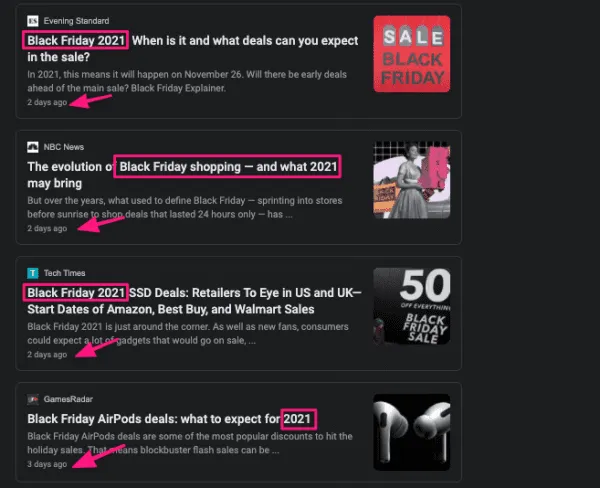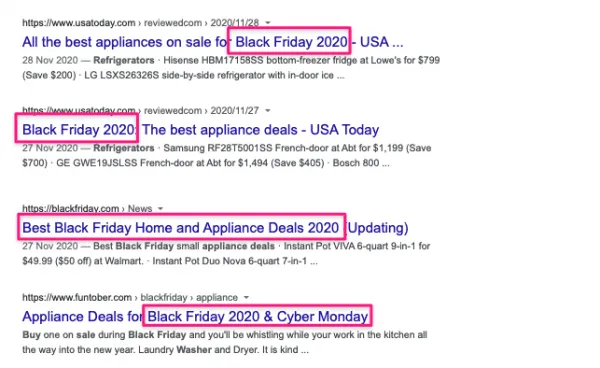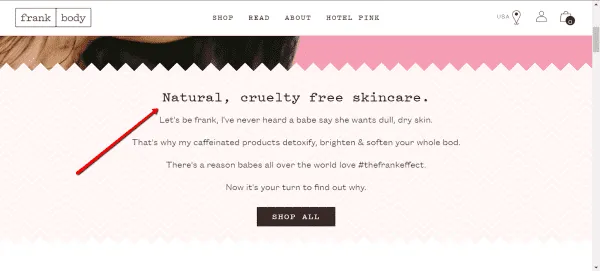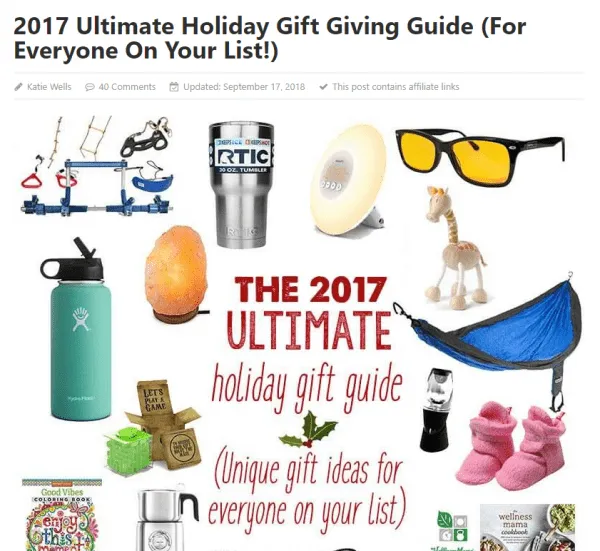
I know it's only September, but 'Black Friday 2021 deals' are already trending on Google news:

For ecommerce, SEO is an important source of organic traffic and customers. Organic search traffic is even more important this year, as ad costs on Facebook on YouTube have risen 89% and 108% already. And the costs may still continue to rise.
As you prepare for Black Friday sales in 2021, you need an SEO checklist to prepare your Shopify store for Black Friday and Cyber Monday 2021.
Black Friday and Cyber Monday used to be a way for brick-and-mortar shops to boost their sales during the holiday season by luring in shoppers with deep discounts on their purchases.
While the BFCM deals continue to dominate the world of retail after Thanksgiving Day, the shopping experience has evolved over the years. Now, whatever can be done in real life can also be done online.
Not only that, but Alibaba has a similar discounted online shopping experience in Asia called Single’s Day on November 11th. Their copycat sales on October 10th and December 12th also generate massive amounts of revenue, making these flash sales incredibly valuable for ecommerce store owners all over the world.
Especially as some countries are still facing lockdown or travel restrictions, online retailers have a huge opportunity to increase their sales and win over customers from traditional brick-and-mortar shops, all without facing the mayhem of the crowds. In-store sales on Black Friday 2020 declined 52% compared to the year before, but online sales surged 22% year-on-year to $9 billion, just on Black Friday itself.
Cyber Monday 2020 was even better, with $10.8 billion in sales.
You have an opportunity to get in on the ecommerce revenue this year - but it'll take a bit of work. While it is tempting to offer a few deals onto your shop and call it a day, your Shopify store will hardly make any sales if your target audience--i.e. eager consumers--doesn’t know about these mind-blowing BFCM deals.
So how do you get their attention (and their purchases)?
Through good, old-fashioned search engine optimization (SEO).
I'm going to break down the basics of SEO for your Shopify store so that you can let online shoppers know that your shop has offers that they simply cannot refuse this upcoming holiday weekend. By understanding core strategies or by leveraging white label SEO services, you can improve your store's visibility to drive more organic traffic and boost sales without needing to handle every technical detail yourself.
Many online stores will spend quite a bit of cash advertising their offers and deals for online shoppers this holiday season. While this is certainly an effective way to share your deals with your customers, it is costly and totally dependent on the platform in which you place your ads.
Instead of going down the rabbit hole of ads and AdWords, it makes more sense to simply get organic traffic by putting your shop in front of people who already intend to make significant purchases during the #BFCM weekend.
The easiest way to do this is by anticipating your potential customers search queries on search engines, like Google.
Much of your target audience will be eagerly searching for the best deals on its favorite products in the month leading up to Black Friday. If you want your online shop to appear at the top of the results pages for these search queries, then you will need to begin your footwork far in advance.
Remember that in order to appear at the top of a search engine results page, you need to implement a few basic search engine optimization (SEO) practices. The same holds true for holiday trends and flash sales.
To do this, you will need to do thorough keyword research and get as many backlinks to your site as possible.
The very first step to increase organic traffic is to rank for specific keywords. In this instance, you will want to rank for keywords related to Black Friday and Cyber Monday.
I've written a guide on how to do keyword research for your ecommerce shop, which will help you get into the nitty gritty of understanding keywords and search queries.
The same rules apply to Black Friday and Cyber Monday, as well as virtually any other holiday.
To begin your keyword research, focus on
When you are doing your research, you will want to pay attention to the following details:
Search Volume - The search volume will tell you how many people are searching for that particular keyword, which tells you how in demand it is. Ideally, the higher the volume, the bigger the audience. As an SEO, I get all of my keyword data from Ahrefs. You can too with their 7-day trial, or check out this super helpful BFCM keyword guide.
Keyword Difficulty - Keyword difficulty refers to how difficult it is to rank for this keyword. This is determined by how many other online businesses are currently ranking for this keyword. The lower the score, the easier it is to rank for that keyword.
Search Engine Results Page (SERP) details -The SERPs will show you which types of links are performing the best, which tells you which types of content your target audience is clicking on. This will help you understand how to present your own content so that it also performs well on the SERPs.
Your Competition - The most important thing that many online store owners forget to take into account is what the competition is currently ranking for. If you want to know exactly what it takes to rank for a certain keyword, then you will need to scope out what your competition is doing in order to rank for that keyword. Pay attention to which pages are ranking for the keyword, how the content on that page is structured, and how many backlinks their website has. In order to rank where they are ranking, or better, you will need to replicate their approach.
Once you have an idea of what your target keywords are, what your competition is doing, and what Google is favoring on the SERPs, then you can go ahead and add content to your shop to snag some of that Black Friday organic traffic.
You can add content on virtually any part of your website and Google will crawl it, index it (basically, store the content in its memory), and use it to decide whether or not to rank your site.
As you can imagine, this can be incredibly time consuming and a logistical nightmare if it is done for every single word on every single website that exists on the Internet.
Instead of crawling all of the content, Google focuses on a few key areas. This is where you will want to put your keywords.
Page titles will appear on the tabs of web browsers, on the titles of social media posts, and, perhaps most importantly, on the links that appear on the SERPs.

If you're searching for Black Friday deals on appliances, these pages will come up top.
I tried to search for "2021 Black Friday deals", but there aren't that many to screenshot -- yet. If you start early, you could claim the top rankings before others with a first-mover advantage.
When you write your page titles, include your most valuable keywords at the beginning of your title. This will not only help you rank higher but also get more clicks from your target audience.
It is no surprise that images are a popular way to share content. With the booming success of Instagram and the preference for images on all other social media platforms, it makes sense that images would have a place on Google as well.
The problem?
Google cannot ‘crawl’ the images like it does the webpages. The way to communicate with Google what your image is about is through alt-tags. Google will crawl the alt-tag and store it in its memory, just like all of the rest of your content.
You can easily add your primary keywords to images via alt-tags within your Shopify platform or through a Shopify app.

All Headings
Because Google cannot continuously crawl all of the words on your website and also cannot simply rely on your titles and image tags, it looks next to the headings on your website.
You can see that Frank Body uses their target keyword “cruelty free skincare” in their heading on their homepage.

Speaking directly to their target audience (and Google) is a big part of Frank Body's marketing strategy
This tells both Google and the reader exactly what their site is about almost immediately. Find opportunities to include your BFCM keywords in headings where relevant and you will boost your rankings for these keywords.
When possible and when it makes sense, include your keywords in your URLs and links. This will confirm with Google that your page is indeed all about the topic of the keyword.
It doesn’t make sense to add Black Friday keywords to all of your product URLs because this holiday weekend comes once a year. That doesn’t mean that you cannot add the keyword to prominent pages, though.
Create a landing page (more details on that, later) that focuses primarily on the deals and offers that your online shop will offer for the holiday weekend and add the keyword to the landing page URL.


Target and Best Buy use this techique too
This not only gives you a great opportunity to stick your target keyword in the URL, but it is also an opportunity to link out to your products throughout your shop. This, too, will tell Google what you’re offering from your cyber deals this holiday season.
So now that you’ve got your keywords in place, it’s time to increase your online visibility and, as a result, your rankings for those keywords.
Search engine optimization is largely determined by backlinks just as much as keywords. Backlinks are simply links to your website that are given by other sites on the Internet. They work a lot like virtual recommendations and the more that you have, the more that Google will recommend your site to its users for relevant search queries.
As you can imagine, getting backlinks takes a bit of time and effort. Building backlinks should be an ongoing process all throughout the year, as an SEO best practice.
If you’re just now starting to work on your backlinks, don’t fret. Any work that you do now will continue to build your authority and rankings throughout the year for every year that follows.
There are many ways for a website to build backlinks, but there are a few quick and dirty ways that will get the job done with minimal effort.
The easiest way to get backlinks is to let your audience do the dirty work for you. All you need to do is create content that your target audience will want to share, over and over again, across the Internet.
Don’t worry, it’s not as hard as it sounds.
The easiest way to disseminate your content is through social media, Pinterest being the easiest platform of all. Pinterest marketing has proven to be invaluable in boosting organic traffic, getting backlinks, and building online authority.
The very first step is to create content that is worth sharing.
Gift guides are super popular no matter your industry. You can easily sift through the online crowds and cut straight to your target audience by creating a gift guide that is specific to your niche market.
Wellness Mama created a gift guide for 2017 and simply updated it for 2018, 2019, and 2020. This allowed her to keep all of her backlinks and social shares from the previous year while still providing value to her target audience.

Her gift guide will keeps snowballing and growing.
Once you create your gift guide, design a Pinterest-sized image to go with it and then share it on all platforms. Update it each year and keep the momentum in your backlinks and rankings for years to come.
Here are some sample titles you can use for your gift guide:
Videos are just as popular as images when it comes to sharing content online. You don’t need to be a professional video editor to create quality videos, either.
Lumen5 provides an affordable option for creating shareable videos within minutes. They provide royalty-free images and videos, customizable design, and a large library of music to accompany your videos.
Another tool that can be useful in creating and sharing videos online is Videvo. Videvo is a website that offers a library of royalty-free stock videos, motion graphics, and audio files that can be used in personal and commercial projects. The website provides a vast collection of video clips and footage in various categories, including nature, technology, business, and more, making it easy for users to find the right video for their projects. In addition, Videvo also offers professional after effects templates for free that can help users create engaging and high-quality videos with ease.
By sharing videos, you are quickly advertising your deals, products, and brand without having to convince the viewer to read through your content.
Here are some sample videos that you can use for your promotion:
Infographics are backlink gold and super easy to make. When creating infographics, keep the target audience in mind. Ask yourself what they might be looking for when they stumble upon your infographic, what will make them interested in sharing it, and what will convince them to click through to your website.
In general, people prefer how-to guides, technical explanations, and data-based infographics.
For your online shop, you could create an infographic that highlights your best-selling product, explains the industry statistics, or outline the best deals in your shop.
You can easily design an infographic on platforms like Easel.ly for free or for a very affordable price.
Once you have your infographic, share it on Pinterest and various infographic directories. Infographic directories give you a backlink to your site and share your infographic with bloggers and social media mavens within your industry.
If they like what you’ve created, then they will share it with their audiences, as well. This is the easiest way to quickly get backlinks and traffic to your website.
Here are some sample infographic topics that will easily be shared:
A static landing page is one that exists on your site year round and has a simple URL structure. Ideally, it would look like www.yoursite.com/black-friday-cyber-monday-deals and would include your target keyword.
This allows you to work on the backlinks each year and build authority on Google even when it’s not the holiday season.
Just like how infographics allow you to submit your site to various directories, so does a landing page focused on deals and offers. When you create your landing page for Black Friday, Cyber Monday, and Single’s Day, submit it to various aggregate sites that advertise the best online deals for consumers.
Some of the most popular sites for BFCM deals that you can submit your page to are SlickDeals, RetailMeNot, and BlackFriday.
As you continue to build your authority, your site will continue to climb the ranks on the search engine results pages. And the higher that you climb, the more organic traffic that you get.
More traffic leads to more sales and that is a very good thing.
When it comes to search engine optimization for your Shopify store or ecommerce business, it is important to keep in mind all of the opportunities to build your site authority throughout the year.
Holiday ecommerce sales are some of the best opportunities of all.
Give yourself a last minute push to boost organic traffic for this upcoming holiday season and then continue to work on it throughout the next year. Your shop and sales will grow along with your traffic.
Happy holidays!
Marquis Matson is an SEO analyst, content marketer, and writer. She specializes in search engine optimization for ecommerce sites in the yoga and wellness niche. She lives as a digital nomad, spending time in Ecuador, California, Thailand, India, Australia, and more. You can find her on LinkedIn, Twitter, or at marquismatson.com.
Grow your sales at a ridiculously
lower CAC.